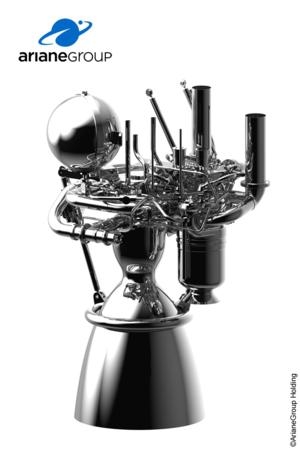Mon, Dec 25, 2017
Precursor For Future European Launch Engines
Prometheus is a European demonstrator for a very low cost reusable engine, running on liquid oxygen (LOx) and methane. It is the precursor for future European launcher engines as of 2030.

The aim is to be able to build future liquid propellant engines with a unit cost of about 1 million euros, or 10 times less than the cost of producing existing engines such as the Vulcain 2. The success of this type of technological challenge demands an entirely new approach and the use of innovative design and production methods and tools. Apart from switching from the traditional Ariane propellant (transition from the liquid oxygen and liquid hydrogen combination to a combination of liquid oxygen and methane), the demonstrator will entail major developments, including digitalization of engine control and diagnostics, and manufacturing using 3D printing in a connected factory environment.
The $88 million contract signed by Daniel Neuenschwander, Director of Space Transportation at the European Space Agency (ESA), and Alain Charmeau, CEO of ArianeGroup, the 50/50 joint-venture set up by the Airbus and Safran groups, covers the design, manufacturing and testing of the first two examples of the Prometheus demonstrator. The French space agency (CNES) is leading in the early design process, and testing is scheduled on the P5 test bed of the German Aerospace Centre (DLR) in Lampoldshausen, Germany, as of 2020.
"The development of Ariane 6 is on track, with a first flight scheduled for 2020. This new Prometheus contract with the European Space Agency is paving the way for the future of European launchers, with the goal of designing and building a reusable engine for one tenth the cost of today's Vulcain 2 type engines. I therefore thank ESA and the Member States for their contribution and their confidence in entrusting us with the development of the European technology of tomorrow."
Following the initial phase which was completed in early December, the first Program Review confirmed the consistency of the design choices with engine specifications and in particular with the recurring cost targets. At the same time, subsystems testing has started with the gas generator campaign (one of the parts built using 3D printing) on the DLR's P8 test bed in Lampoldshausen.
(Image provided with ArianeGroup news release)
More News
According To The Witness, Once The Airplane Landed, It Continued To Roll In A Relatively Straight Line Until It Impacted A Tree In His Front Yard On November 4, 2025, about 12:45 e>[...]
"In the frame-by-frame photos from the surveillance video, the left engine can be seen rotating upward from the wing, and as it detaches from the wing, a fire ignites that engulfs >[...]
Radar Required A term displayed on charts and approach plates and included in FDC NOTAMs to alert pilots that segments of either an instrument approach procedure or a route are not>[...]
From 2023 (YouTube Edition): It’s a Small World After All… Founded in 2011 by pilot, aircraft designer and builder, and U.S. Air Force veteran Sam Watrous, Uncasville,>[...]
Also: UFC Buys Tecnams, Emirates B777-9 Buy, Allegiant Pickets, F-22 And MQ-20 The NTSB's preliminary report on the UPS Flight 2976 crash has focused on the left engine pylon's sep>[...]
 NTSB Prelim: Funk B85C
NTSB Prelim: Funk B85C Aero-News: Quote of the Day (11.21.25)
Aero-News: Quote of the Day (11.21.25) ANN's Daily Aero-Term (11.21.25): Radar Required
ANN's Daily Aero-Term (11.21.25): Radar Required Classic Aero-TV: ScaleBirds Seeks P-36 Replica Beta Builders
Classic Aero-TV: ScaleBirds Seeks P-36 Replica Beta Builders Airborne 11.21.25: NTSB on UPS Accident, Shutdown Protections, Enstrom Update
Airborne 11.21.25: NTSB on UPS Accident, Shutdown Protections, Enstrom Update



